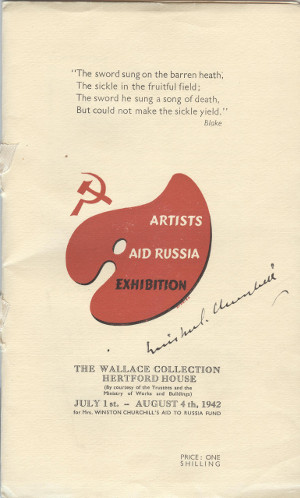Archives Hub feature for September 2015
In 1897 Lady Wallace died and bequeathed the contents of the ground and first floor of Hertford House, her art-filled London residence, to the nation. This included paintings by Rembrandt, Reynolds and Canaletto, the finest collection of Sèvres porcelain in the world and nearly 2, 500 pieces of arms and armour. These items were collected by the first 4 Marquesses of Hertford and Sir Richard Wallace, the illegitimate son of the 4th Marquess.
The Wallace Collection Archives consist of papers relating to the founders, records of the Museum’s history and activities, and discrete archive collections relating to our subject specialist areas of French 18th century art, princely arms and armour and the history of collecting.
The Hertford and Wallace family archive paints a picture of the lives of the founders and how their art collection grew over the course of the 19th century. The archive holds a number of inventories revealing the contents of properties owned by the collectors on their deaths; these include objects in the collection today and items which were not included in Lady Wallace’s bequest.
The inventory taken on Sir Richard Wallace’s death in 1890 reveals that Lady Wallace’s bed was ‘a 6ft carved and gilt Parisian bedstead, stuffed head, and footboard covered in blue silk’ costing £200 (over £12,000 in today’s money). We know that Lady Wallace was a fan of Fragonard’s The Swing as it was one of the 15 paintings she chose to adorn her bedroom.

The inventory shows that Richard Wallace had 8 horses, with names ranging from the more common Rodney to the clearly art-inspired Rembrandt, and 12 carriages for himself and his wife. Plans in the archive reveal that what were once the stables and coach house are now the arms and armour galleries. A mezzanine level was in place between the ground and first floors, where the stable boys and coachman’s family slept; the stable boys directly above the stables and the coachman’s family in a flat above the coach house.

Following Lady Wallace’s death a government enquiry determined that the Collection should remain in Hertford House and it was bought for the nation from her heir and former secretary, John Murray Scott. A large amount of building work was required to make Hertford House more suitable to display the Collection. For example, the mezzanine level above the stables was removed to create higher ceilings.
The Wallace Collection opened to the public on June 22 1900. John Murray Scott was appointed the first chairman of the Board of Trustees; he remained chairman until his sudden and dramatic death in 1912. Trustee minutes in the museum archive reveal that: ‘Sir John Scott was taken ill in the Boardroom about 12:30pm on Wednesday 17 January. At the moment of his seizure he was conversing on the history of the collection, and giving the Keeper notes on various objects contained in it. He died little more than an hour later.’

On the outbreak of the First World War the Trustee minutes record that fire extinguishing equipment was purchased in case the Wallace Collection took a direct hit in aircraft raids. In 1916 the Collection was closed due to a lack of staff and in 1917 the decision was taken to evacuate the collection to the Post Office Underground Railway at Paddington – the move was completed in October 1918, one month before the Armistice. Various government departments used Hertford House during the war and it wasn’t until November 1920 that the Collection was able to re-open.
The archive reveals that the Collection was well-prepared for the Second World War, with planning for the possible evacuation of the Collection starting as early as 1933. Meetings were held on a regular basis throughout the mid-1930s and when the Munich Crisis occurred in 1938 the rarest Sèvres and majolica objects in the Collection were packed as a precaution. Priority lists were drawn up and practice drills held so when on August 23 1939 the Home Office gave the word ‘GO!’ to all the national museums and galleries to evacuate, the Wallace Collection was ready.

In fact they were so prepared that when Sir James Mann, the Director of the Museum at the time, returned from the continent on August 28 he found ‘Hertford House practically empty’. Between August 24 and September 4 the vast majority of the Collection was transported in 28 lorry journeys to Hall Barn and Balls Park. As with most national museums and galleries, the Collection remained outside London for the duration of the Second World War.
Hertford House itself had many lucky escapes during the Blitz; on the night of September 18/19 1940 a high explosive bomb fell in the front garden but did surprisingly little damage. Incendiary bombs fell on the roof in November 1940 and May 1941 but museum staff put the fires out before more than slight damage to the woodwork was caused.

Hertford House was not completely empty during the war as it was made available for temporary exhibitions, including the Arts and Crafts (1941) and Artists Aid Russia (1942) exhibitions. Below is a catalogue for the latter exhibition signed by Sir Winston Churchill; it was auctioned for Mrs Churchill’s Aid for Russia fund and presented to the Wallace Collection by Sir Alec Martin in 1942.
Information about most of our collected archives can be found on our Archives Hub contributor’s page, further descriptions including those for the family and museum archives will be added in due course.
Carys Lewis
Archivist & Records Manager
Related
Browse the collections of The Wallace Collection on the Archives Hub.
